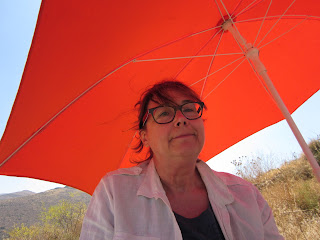Field work, Day 1, was mostly spent unpacking the car,
setting up and organizing the field office, establishing the survey base, and
disassembling the first batch of seismic stations that had been recording since
last September. Then it was off to the supermarket for basic supplies such
as 2 liter bottles of water, sandwich making material, tomatoes, cucumbers,
retsina, and ouzo. The absolute basics.
Days 2 and 3 were mostly spent in that nasty form of field
limbo that geophysicists are sent to when things don't work: waiting for
permits, endless discussions about why things don't work, and making trips to
get parts and odds and ends. But despite the threat of rain, we made our first
passive seismic measurements in Midea. Hurrah!
 |
| Klaus, Gregor, Hector and Evi leveling seismometers in Midea |
 | |
| Evi measuring a GPS location on a rock in Tiryns (they're digging in the wrong place, Indie!) |
Another important accomplishment was checking the extent of
our new differential GPS in preparation for measuring a gravity profile
extending all the way from Tiryns to Midea. Measuring gravity requires precise
locations, especially elevation, because gravitational anomalies – those are
the interesting things – can only be well modeled if the single points that are
measured with a gravimeter are well known. The tidal corrections, elevation
corrections, geoid corrections, etc. and so on, all depend on the accuracy of the
locations. We are using a Scintrex CG-5 gravimeter that our Belgian colleagues
Michel von Camp and Thierry Camelbeeck at the Royal Observatory in Brussels
haven generously lent us for the experiments.
While doing our base station tests, we stopped near the
house where we had installed a seismometer last year. The nice Greek
grandmother who owns the house saw us and made us come inside where she plied
us with cucumbers (from her garden), melons (from the neighbor's garden) and
fresh well water. I wouldn't have understood a word of her non-stop exuberant
conversation if it hadn't been for our versatile and multi-talented geophysicist
helper Evi Seferou. Evi kept up a simultaneous translation of Grandma's speech
which alternated between exhortations (Eat! Eat! You are all too thin!) and
stories about her children, her garden, and whether we wanted to stay the night
and keep her company. We brought her cookies the next day, and she yelled even
more loudly over the fence and gave us more cucumbers to take home.
 |
| A very nice Greek grandmother. Part of me wanted to take her home with us. |
Day 4 was also mostly spent in discussions – it seems that
the Greeks are very keen on this. Then after all the tiniest details had been
covered, we began to clear the East Gallery in Tiryns in preparation
for the 3D laser scanning. It was rank under-gardener work with an industrial
weed cutter and hand-pulling dried grasses and the occasional Spritzgurke. Science at its
least glamorous. These are the pictures they don't show you in the BBC or Nova
presentations about how science works.
 |
| Under-gardening on a Mycenaean ruin |
 |
| Friends for life - Gregor and an industrial-strength weedeater. |
Saturday, we worked until late afternoon – first measuring
the gravity along the windy road leading up the slope to the acropolis of
Midea. We were only seriously interrupted once by a goat-herding Greek
grandmother (the second grandmother in a series of four). She wanted us to move
the car because the goats wouldn't go past it. Superstitious goats? Not fond of
French cars (Citroen)? She screamed at us (and not the goats) but did not offer
us either cucumbers or melons. Her daughter came with a stick and length of
thick rubber hose to encourage the goats to follow her. The hose made a low
frequency noise as she dragged it behind her that enticed the goats.
 |
| Goat and grandmother |
Evi told me
that all the small landholders here have goats or sheep, a few olive or orange
trees and impressive gardens (for cucumbers and melons). The government pays a
small amount per annum to promote the continuance of the local farming economy.
It's not enough to live on. Most of the farmers produce enough for their own
use but not much more.
 |
| The road goes ever on and on - the windy drive leading to ancient Midea, for example |
Just call me the human raisin because that's what I'll be
after another week in the Greek countryside with average temperatures around
midday of 34o C in the shade. The east European heat wave is holding
strong (probably at least until September), and is now accompanied by a
hot wind. This is the perfect weather for a sweaty day in the field. It's the
beginning of our second week.
We completed the planned gravity profile between Tiryns and
Midea (40 points total) and three passive seismic arrays. It was not easy.
Another screaming Greek grandmother – the Greek name for them is giagiá (pronounced yaya – with emphasis
on the second syllable) – threatened the passive seismic crew (Klaus-G. Hinzen and
Gregor Schweppe) until Evi calmed her down and convinced her we were not out to
steal her land or the hidden gold. Greek men on mopeds were asking what we –
Evi and I, the gravity crew – were doing on their land. Our story was
convincing enough: that we are investigating the substructure, searching for local
faults. One cute Greek guy asked if we were looking for gold. Apparently
everyone believes there are hordes of gold secreted all over Greece. Nearly
everyone has a map from someone's grandfather with an 'x marks the spot'. Myself,
I would just be happy with a hidden grotto with cool spring water and some
shade trees.
 |
| Hot but not bothered |
Next up, Laser scanning, wildlife, and more! Greek grandmothers.

No comments:
Post a Comment